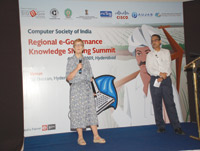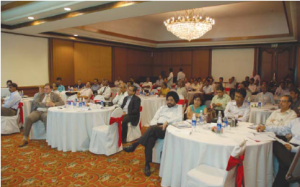 Standardisation of information collection, storage and digitisation of forms are the key factors for making e-Government services work in India
Standardisation of information collection, storage and digitisation of forms are the key factors for making e-Government services work in India
INDIA took a major leap of faith on September 18, 2006, when the Ministry of Company Affairs (MCA) made e-Filing of returns to the Registrar of Companies (RoC) mandatory for all companies in India.
The initiative under the country’s MCA 21 project was aimed at automating the processes related to the proactive enforcement and compliance of the legal requirements under the Companies Act, 1956. , For the project, fortunately, standardisation of its various forms was not a big hindrance as the proposed service, despite being a nationwide roll-out, was related to just one department, and there was enough political and bureaucratic support to ensure its smooth run.

However, despite a massive success of the project that has truly enabled anytime and anywhere MCA services to businesses, the other departments which interact with these businesses cannot, in any way, benefit from the repository of valuable data that the Ministry collects from companies and its directors from across the country.
Besides, it also does not allow companies to significantly streamline their interaction with the government as they are still required to re-file the same or substantially similar information to multiple departments.

This issue may however soon be a thing of past once departments start following standards for electronic forms and share common information on individuals and businesses. Experts suggest that standardisation of information collection, storage and digitisation of forms are the next crucial steps for making e-Government services successful in the country.
 Joan McCalla and Prakash Kumar of Internet Business Solutions Group, Cisco at CSI Regional e-Governance Summit 2009, Hyderabad
Joan McCalla and Prakash Kumar of Internet Business Solutions Group, Cisco at CSI Regional e-Governance Summit 2009, Hyderabad
As a foundation step, some of the states have already deployed State Wide Area Networks (SWANs) and are in the process of completing Common Service Centers (CSC) deployment and putting in place the State Data Centers (SDCs). In India, eForms will ride on these three pillars-SWAN, SDC and CSC.
The SWAN infrastructure helps in connecting all state government offices, horizontally and vertically SDC is used for hosting the state service delivery gateway (SSDG) and state portal and forms the main engine of e-Forms.
CSC is the main access point for citizens and will be used for filling up e-Forms from a remote rural location .
Cisco has played a major role in building these pillars.
Once the infrastructure is in place, state governments would be loading applications on the SWAN, which can be accessed through the SSDG. These gateways will provide a single window access to the information and services of the Indian government at all levels – from panchayat to the central government. By simply filling in specific forms with the required information at nearby CSCs, all citizens, including those in remote rural areas, will be able to access data and apply for certificates etc with the click of a mouse.
Standardisation: The Biggest Challenge
While one of the key elements of India’s National e-Governance Plan (NeGP) is the CSC project, the country still needs to travel a long way before it can actually achieve this objective.
Presently there are hundreds of forms related to both government to citizen (G2C) and government to business (G2B) services provided by all the three layers of the government i.e. central, state and municipal governments. Many of them vary widely from state to state. For example, different states have different formats with respect to birth certificate, domicile certificate, RTI, various welfare schemes etc. In the same state, the format at times varies from district to district.
 The reason for this can be attributed to the fact that many such services are state subjects and are governed by local laws, which have evolved over many years. Also lack of standardisation procedures in absence of automated functioning is another major cause. Now with the Government of India focusing on automation of all the departments within central and state government through central Mission Mode Projects (MMPs), state MMPs and integrated MMPs there needs to be a well defined process and standard for all forms.
The reason for this can be attributed to the fact that many such services are state subjects and are governed by local laws, which have evolved over many years. Also lack of standardisation procedures in absence of automated functioning is another major cause. Now with the Government of India focusing on automation of all the departments within central and state government through central Mission Mode Projects (MMPs), state MMPs and integrated MMPs there needs to be a well defined process and standard for all forms.
Both information collection and storage need to be standardised so that forms on central and state portals use one standard format– this will enable users download, fi ll and submit applications electronically in a consistent manner nationwide. The e-Governance infrastructure project also guarantees assured electronic delivery of the request from the citizen to the specifi ed fi eld offi ce of the government department, followed by electronic acknowledgement of successful submission of application or request from a department to the citizen.
The back end processing at the department may initially continue in a manual mode. Gradually as MMPs and state applications get implemented and the backend gets computerised, the functionality of the services provided will get enhanced and eventually all services will be provided online and can be accessed through state portals in an integrated fashion.
Secondly, availability of the forms through the CSCs will increase convenience to villagers and signifi cantly reduce the time and costs they incur in accessing government services. What is more, the reduced contact between citizen and government departments will increase effi ciency and productivity of departments allowing department staff to redirect their efforts to resolving the most complicated cases.
Further, the greater transparency in service delivery will also hopefully lead to reduced corruption, thereby changing the image of the government among citizens.
To take the initiative further, Department of Information and Technology (DIT) has asked CDAC to develop a “Form Engine” which could be used by the states and the Union Territories (UTs) to generate e- Forms and showcase capability of routing the e-Forms to different departments. The engine is also expected to support all 22 offi cial languages of India.
CHALLENGES FACING E-FORMS ROLLOUT
e-Forms have been started on a pilot basis in a few states and there is still some distance to be covered before full scale implementation. Some of the problem areas related to e-Forms implementation stem from management issues and people issues. All these issues need to be sorted out so that e-Forms roll-out in the states is smooth and all stakeholders benefi t due to excellent time bound quality of service.
A key management issue to be resolved is identifi cation of gaps in infrastructure for roll-out of e-Forms. Also important is ensuring ownership by line departments for the information and processes required to support e-Forms within states as well as development of a mechanism for monitoring timely disposal of electronic applications.
Work is underway to provide unique acknowledgement number at the national level for all applications whether made to central/state departments or municipal authorities so that tracking becomes easier and every application across the country has one unique acknowledgement number. Tracking applications using mobile phones is also on the agenda.
People issues are also important and should not be neglected as the focus should be on business process reengineering. Persons responsible for different processes need to be identifi ed and staff at all levels need to be trained in how their functions differ as e-Forms are introduced. The absence of back-end automation will mean additional work for updating applications and it needs to be factored while allocating work. On the plus side, introduction of e-Forms will generate signifi cant information on where work loads are greatest/lowest and allow for improved planning. \\
Be a part of Elets Collaborative Initiatives. Join Us for Upcoming Events and explore business opportunities. Like us on Facebook , connect with us on LinkedIn and follow us on Twitter, Instagram.











